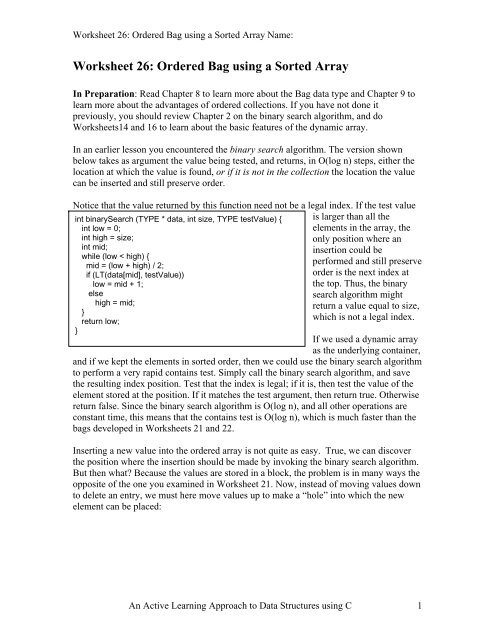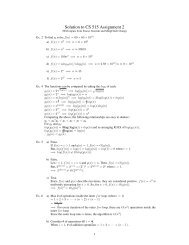Worksheet 26: Ordered Bag using a Sorted Array - Classes
Worksheet 26: Ordered Bag using a Sorted Array - Classes
Worksheet 26: Ordered Bag using a Sorted Array - Classes
Create successful ePaper yourself
Turn your PDF publications into a flip-book with our unique Google optimized e-Paper software.
<strong>Worksheet</strong> <strong>26</strong>: <strong>Ordered</strong> <strong>Bag</strong> <strong>using</strong> a <strong>Sorted</strong> <strong>Array</strong> Name:<br />
<strong>Worksheet</strong> <strong>26</strong>: <strong>Ordered</strong> <strong>Bag</strong> <strong>using</strong> a <strong>Sorted</strong> <strong>Array</strong><br />
In Preparation: Read Chapter 8 to learn more about the <strong>Bag</strong> data type and Chapter 9 to<br />
learn more about the advantages of ordered collections. If you have not done it<br />
previously, you should review Chapter 2 on the binary search algorithm, and do<br />
<strong>Worksheet</strong>s14 and 16 to learn about the basic features of the dynamic array.<br />
In an earlier lesson you encountered the binary search algorithm. The version shown<br />
below takes as argument the value being tested, and returns, in O(log n) steps, either the<br />
location at which the value is found, or if it is not in the collection the location the value<br />
can be inserted and still preserve order.<br />
Notice that the value returned by this function need not be a legal index. If the test value<br />
int binarySearch (TYPE * data, int size, TYPE testValue) { is larger than all the<br />
int low = 0;<br />
elements in the array, the<br />
int high = size;<br />
only position where an<br />
int mid;<br />
insertion could be<br />
while (low < high) {<br />
performed and still preserve<br />
mid = (low + high) / 2;<br />
if (LT(data[mid], testValue))<br />
order is the next index at<br />
low = mid + 1;<br />
the top. Thus, the binary<br />
else<br />
search algorithm might<br />
high = mid;<br />
return a value equal to size,<br />
}<br />
which is not a legal index.<br />
return low;<br />
}<br />
If we used a dynamic array<br />
as the underlying container,<br />
and if we kept the elements in sorted order, then we could use the binary search algorithm<br />
to perform a very rapid contains test. Simply call the binary search algorithm, and save<br />
the resulting index position. Test that the index is legal; if it is, then test the value of the<br />
element stored at the position. If it matches the test argument, then return true. Otherwise<br />
return false. Since the binary search algorithm is O(log n), and all other operations are<br />
constant time, this means that the contains test is O(log n), which is much faster than the<br />
bags developed in <strong>Worksheet</strong>s 21 and 22.<br />
Inserting a new value into the ordered array is not quite as easy. True, we can discover<br />
the position where the insertion should be made by invoking the binary search algorithm.<br />
But then what? Because the values are stored in a block, the problem is in many ways the<br />
opposite of the one you examined in <strong>Worksheet</strong> 21. Now, instead of moving values down<br />
to delete an entry, we must here move values up to make a “hole” into which the new<br />
element can be placed:<br />
An Active Learning Approach to Data Structures <strong>using</strong> C 1
<strong>Worksheet</strong> <strong>26</strong>: <strong>Ordered</strong> <strong>Bag</strong> <strong>using</strong> a <strong>Sorted</strong> <strong>Array</strong> Name:<br />
As we did with remove, we will divide this into two steps. The add method will find the<br />
correct location at which to insert a value, then call another method that will insert an<br />
element at a given location:<br />
void ordered<strong>Array</strong>Add (struct dy<strong>Array</strong> *da, TYPE newElement) {<br />
int index = binarySearch(da->data, da->size, newElement);<br />
dy<strong>Array</strong>AddAt (da, index, newElement);<br />
}<br />
The method addAt must check that the size is less than the capacity, calling<br />
dy<strong>Array</strong>DoubleCapacity if not, loop over the elements in the array in order to open up a<br />
hole for the new value, insert the element into the hole, and finally update the variable<br />
count so that it correctly reflects the number of values in the container.<br />
void dy<strong>Array</strong>AddAt (struct dy<strong>Array</strong> *da, int index, TYPE newElement) {<br />
int i;<br />
assert(index >= 0 && index size);<br />
if (da->size >= da->capacity)<br />
_dy<strong>Array</strong>DoubleCapacity(da);<br />
… /* you get to fill this in */<br />
}<br />
The method remove could use the same implementation as you developed in Chapter B.<br />
However, whereas before we used a linear search to find the position of the value to be<br />
deleted, we can here use a binary search. If the index returned by binary search is a legal<br />
position, then invoke the function dy<strong>Array</strong>RemoveAt that you wrote in <strong>Worksheet</strong>14 to<br />
remove the value at the indicated position.<br />
On Your Own<br />
Fill in the following Chart with the big-oh execution times for the simple unordered<br />
dynamic array bag (Lesson X), the linked list bag (Lesson x) and the ordered dynamic<br />
array bag (this worksheet).<br />
Dynamic <strong>Array</strong> <strong>Bag</strong> LinkedList<strong>Bag</strong> <strong>Ordered</strong> <strong>Array</strong> <strong>Bag</strong><br />
Add O( O( O(<br />
Contains O( O( O(<br />
Remove O( O( O(<br />
An Active Learning Approach to Data Structures <strong>using</strong> C 2
<strong>Worksheet</strong> <strong>26</strong>: <strong>Ordered</strong> <strong>Bag</strong> <strong>using</strong> a <strong>Sorted</strong> <strong>Array</strong> Name:<br />
Which operations are faster in an unordered collection? Which operations are faster in an<br />
ordered collection? Based on this information, can you think of an example problem<br />
where it would be better to use an unordered collection? What about an example problem<br />
where it would be better to use an ordered collection?<br />
Short Answers<br />
1. What is the algorithmic complexity of the binary search algorithm?<br />
2. Using your answer to the previous question, what is the algorithmic complex of<br />
the method contains for an <strong>Ordered</strong><strong>Array</strong><strong>Bag</strong>?<br />
3. What is the algorithmic complexity of the method addAt?<br />
4. Using your answer to the previous question, what is the algorithmic complexity of<br />
the method add for an <strong>Ordered</strong><strong>Array</strong><strong>Bag</strong>?<br />
5. What is the complexity of the method removeAt? of the method remove?<br />
/*These have been written already and you can use them */<br />
void _dy<strong>Array</strong>DoubleCapacity (struct dy<strong>Array</strong> * dy);<br />
void dy<strong>Array</strong>Init (struct dy<strong>Array</strong> * dy, int initialCapacity);<br />
void dy<strong>Array</strong>RemoveAt (struct dy<strong>Array</strong> * dy, int position);<br />
void dy<strong>Array</strong>AddAt(struct dy<strong>Array</strong> *dy, int position, TYPE val);<br />
int _binarySearch(TYPE *data, int size, TYPE testValue);<br />
/* These are the new functions to take advantage of the ordered dynamic array */<br />
int dy<strong>Array</strong>BinarySearch (struct dy<strong>Array</strong> * dy, TYPE testValue) {<br />
return _binarySearch (dy->data, dy->size, testValue); }<br />
void ordered<strong>Array</strong>Add (struct dy<strong>Array</strong> *dy, TYPE newElement) {<br />
int index = _binarySearch(dy->data, dy->size, newElement);<br />
dy<strong>Array</strong>AddAt (dy, index, newElement);<br />
}<br />
An Active Learning Approach to Data Structures <strong>using</strong> C 3
<strong>Worksheet</strong> <strong>26</strong>: <strong>Ordered</strong> <strong>Bag</strong> <strong>using</strong> a <strong>Sorted</strong> <strong>Array</strong> Name:<br />
/* you must complete the following */<br />
int ordered<strong>Array</strong>Contains (struct dy<strong>Array</strong> *dy, TYPE testElement) {<br />
}<br />
void ordered<strong>Array</strong>Remove (struct dy<strong>Array</strong> *dy, TYPE testElement) {<br />
}<br />
An Active Learning Approach to Data Structures <strong>using</strong> C 4

















